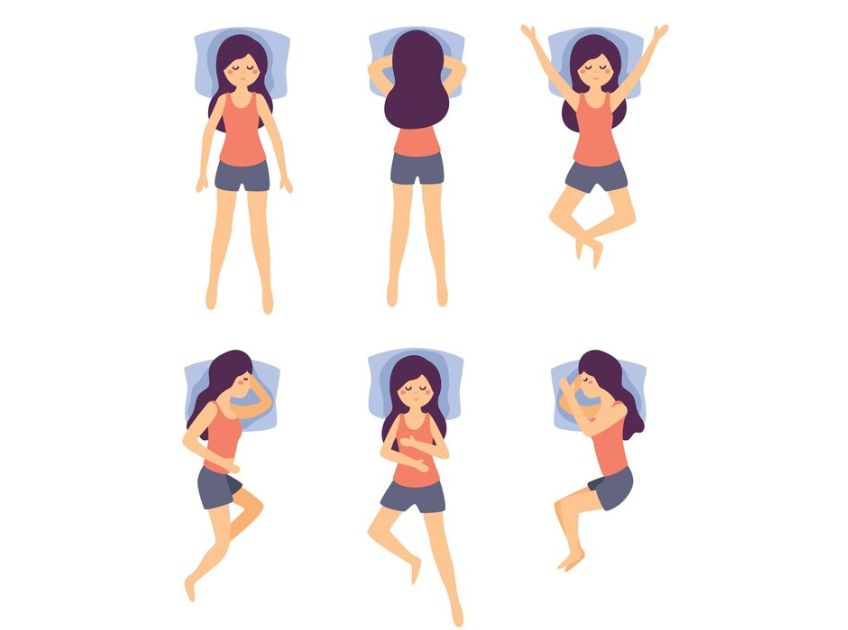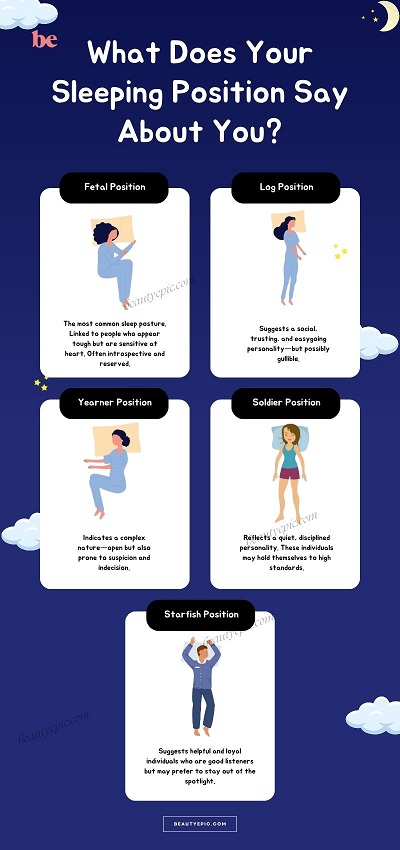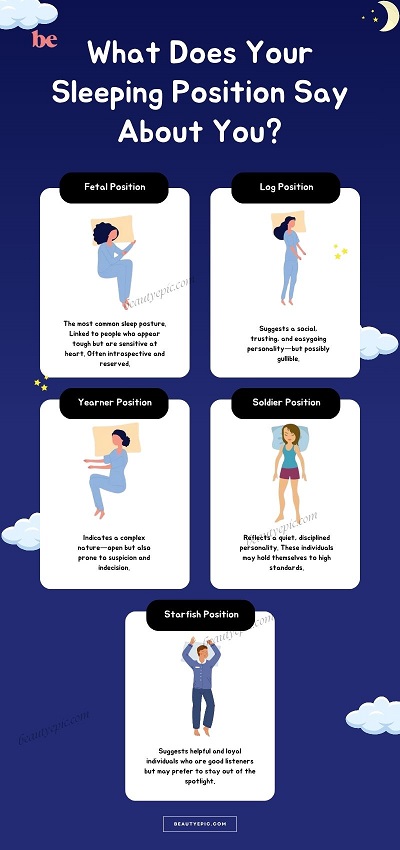
Important: This article is for informational purposes only. Please read our full disclaimer for more details.
Ever wondered if the way you sleep could reveal something deeper about your personality or health? Whether you curl up in a fetal ball or sprawl across the bed like a starfish, your go-to sleeping position may reflect more than just comfort—it could offer surprising insights into your mental state and physical well-being. Let’s dive into what science and psychology have to say about it.
Personality in Posture: What Your Sleeping Position May Reveal About You
While not a definitive science, several behavioral studies suggest a connection between habitual sleeping positions and personality traits. Research conducted by Professor Chris Idzikowski, a UK sleep expert, revealed interesting correlations:
- Fetal Position (side curled):
The most common sleep posture. Linked to people who appear tough but are sensitive at heart. Often introspective and reserved. - Log Position (straight on the side):
Suggests a social, trusting, and easygoing personality—but possibly gullible. - Yearner Position (side with arms out):
Indicates a complex nature—open but also prone to suspicion and indecision. - Soldier Position (flat on back, arms at sides):
Reflects a quiet, disciplined personality. These individuals may hold themselves to high standards. - Starfish (flat on back, arms overhead):
Suggests helpful and loyal individuals who are good listeners but may prefer to stay out of the spotlight.
Fun Fact: A Sleep Assessment and Advisory Service study found over 41% of people sleep in the fetal position (1).
Sleep Posture and Physical Well-Being: What Science Says
Your sleep position does more than hint at your personality—it can directly impact your physical health, especially when it comes to spinal alignment, digestion, and breathing.
- Back Sleeping:
Can cause or worsen snoring and sleep apnea, but supports neck and spine alignment if done correctly. - Side Sleeping (especially left side):
Recommended for digestion and reducing acid reflux. May reduce back and neck pain. - Stomach Sleeping:
Often leads to neck strain and lower back pain due to spinal misalignment. - Fetal Position:
Great for lower back pain and pregnancy, though overly tight curling may restrict deep breathing.
Scientific Backing: According to a 2017 article in the Journal of Clinical Sleep Medicine, side sleeping—particularly on the left side—may support heart health and aid lymphatic drainage (2).
How to Sleep Smarter: Position Tips for a Healthier Night’s Rest
Adopting a healthier sleep posture doesn’t require drastic changes—it starts with understanding your body’s needs and making intentional adjustments to support alignment, reduce pressure, and improve circulation. Here’s a deeper look at how to optimize each sleeping position for better rest and long-term wellness:
1. Back Sleepers: Support the Spine and Reduce Pressure
Sleeping on your back can be great for spinal health when done correctly, but it can also lead to snoring or worsen sleep apnea for some. Proper alignment is key:
- Use a low-to-medium-loft pillow under your head to keep your neck in a neutral position.
- Add a small pillow under your knees to relieve pressure on the lower back and promote the spine’s natural curve.
- Avoid stacking multiple pillows under your head, which can push your head forward and strain your neck.
Expert Insight: A 2021 review published in Sleep Science and Practice emphasizes the importance of knee elevation in maintaining lumbar support during supine sleep (3).
2. Side Sleepers: Align the Hips and Shoulders
Side sleeping is one of the most recommended positions for reducing acid reflux, improving digestion, and enhancing circulation—especially when sleeping on the left side. However, it can also cause shoulder or hip discomfort without proper support.
- Place a firm pillow between your knees to keep your hips aligned and reduce pressure on the lower back.
- Use a thicker pillow for your head to fill the space between your ear and shoulder, keeping the neck neutral.
- Alternate sides regularly to avoid developing pressure imbalances, such as facial wrinkles or one-sided shoulder pain.
Scientific Backing: According to a study in The Journal of Clinical Gastroenterology, sleeping on the left side may ease nighttime heartburn due to gravity’s influence on the stomach and esophagus (4).
3. Fetal Sleepers: Curl Gently, Not Tightly
The fetal position is the most popular worldwide—providing a comforting, protective posture that can help ease tension in the lower back. However, curling too tightly can restrict deep breathing and compress organs.
- Loosen the curl slightly to avoid undue pressure on the diaphragm.
- Support your arms and knees with a body pillow or extra cushions to reduce joint stress.
- Consider a memory foam mattress to cushion key pressure points like the hips and shoulders.
Tip: Pregnant women often favor a modified fetal position on the left side with a pregnancy pillow to support the belly and lower back.
4. Stomach Sleepers: Minimize Neck Strain
Stomach sleeping is the least recommended position due to its tendency to strain the neck and lower back. If you find it difficult to change this habit, there are small tweaks to reduce discomfort:
- Ditch the pillow or use a very thin one to prevent the neck from being forced into an unnatural angle.
- Place a pillow under your pelvis to ease lower back pressure.
- Try to sleep with your head turned slightly rather than sharply to reduce cervical tension.
- Train yourself to shift to side sleeping by using a body pillow as a gradual transition tool.
Note: The American Academy of Sleep Medicine advises stomach sleepers to adopt side or back sleeping to reduce spinal misalignment and enhance breathing (5).
5. Pillow and Mattress Tips for All Sleepers
Your mattress and pillow can either support or sabotage your sleep posture. Choosing the right materials makes a noticeable difference:
- Medium-firm mattresses provide balanced support and reduce sinking, helping maintain natural spinal curves.
- Memory foam or latex mattresses can contour to your body and distribute weight evenly.
- Replace pillows every 12–18 months and mattresses every 7–10 years to ensure consistent support.
- Adjust pillow height based on your preferred position—higher for side sleepers, lower for back or stomach sleepers.
Pro Tip: Listen to your body. If you’re waking up stiff, sore, or restless, your sleeping position—or your sleep setup—may need a simple fix.
Frequently Asked Questions (FAQ’S)
Q1: Can my sleep position cause health problems?
A: Yes. Poor alignment can lead to back, neck, or hip pain over time. Stomach sleeping is most commonly associated with musculoskeletal strain.
Q2: Is it okay to change sleep positions during the night?
A: Absolutely. Most people shift positions multiple times. What’s more important is your starting position and whether your body is supported properly.
Q3: Which sleeping position is best during pregnancy?
A: The left side is considered ideal for pregnant women as it improves circulation to the heart and fetus while reducing pressure on the liver.
Final Thoughts
Your sleeping position isn’t just about comfort—it reflects elements of your personality and plays a critical role in your physical health. While there’s no one-size-fits-all answer, being aware of how you sleep and making thoughtful adjustments can lead to better rest, reduced pain, and even better digestion. Whether you’re a fetal curler or a back-snoozer, your sleep style says more than you realize—so listen to your body and sleep smart.


















